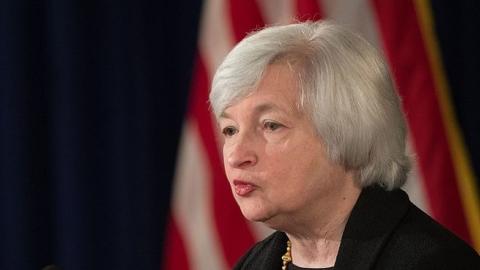This week’s ritual, semi-annual testimony of the Federal Reserve chief before Congress provides a last opportunity for that institution to redeem itself before the Janet Yellen era comes to an end (her term expires January 2018). The late Senator Jim Bunning did just that for a previous Fed chairmanship when, during Ben Bernanke’s reappointment hearing in December 2009, Bunning announced that “you are the definition of moral hazard.” And now, today? Will anyone in Congress point out that Yellen has blighted the U.S. economy and darkened the American Dream by pursuing a colossally misguided—and arguably illegal; the Fed’s authorizing legislation specifies price stability, not arbitrary targets, as its institutional aim—2 percent perpetual inflation goal?
It’s been 20 years since that fateful, Alan Greenspan-era Federal Open Markets Committee meeting at which Professor Yellen, then a Fed governor, delivered her famous paper suggesting that the central bank abandon further inflation-fighting efforts and instead seek to preserve price growth at a steady rate of 2 percent per annum. The argument involved a mish-mosh of Keynesian concerns about “money illusion” (positive inflation theoretically makes real wages more flexible) and zero-interest traps (situations in which inflation is already so low that the Fed cannot effectively employ lending-rate reductions as a response to economic recession). No one at this FOMC meeting challenged these arguments, though both are dubious. Chairman Greenspan was worried that Congress might revolt against an announced formal policy of permanent inflation but nevertheless agreed not to pursue further price-depressing moves. And despite Greenspan’s fears, Congress didn’t revolt—and has never revolted these past two decades, even as the Fed’s commitment to a 2 per cent inflation target has become ever more explicit and entrenched.
In the meantime, unfortunately, economic globalization and the technology revolution have put substantial downward pressure on prices—and made a cruel mockery of “2 percent inflation” and other such central bank dogmas. It was all perfectly predictable. If central bankers try to push prices higher when the natural tendency is strongly lower, the result is virulent asset-price inflation: below-neutral interest rates engineered to arrest deflation inevitably encourage investors to chase yield in riskier and riskier, bubble-prone sectors. By contrast, in a well-functioning capitalist economy grounded in a sound-money regime, prices follow their organic rhythm—sometimes down, sometimes flat, sometimes up, but always and ultimately reverting to a constant mean over very long periods of time. This is a basic and obvious rule of monetary policy. But the Fed—and the European Central Bank, and the Bank of England, and the Bank of Japan—somehow convinced themselves that it could be freely ignored.
Alas, they were wrong—as real-world markets have demonstrated again and again. Obstinate central bank adherence to hard and fast inflation targets, in defiance of natural price cycles, produced the boom and bust of 1997-2001. And then the bubbles and bust of 2003-7. And, most recently, since 2010, a vast balloon of equity and commodity speculation the eventual end of which cannot be precisely timed, though a great many experts fear it will be brutal when it comes. Fear and uncertainty like this goes a long way to explain the general reticence of businesses to invest in long-gestation projects, and that reticence, in turn, acts as a heavy drag on global recovery. How different—and better—might economic and political outcomes have been had the inflation-targeting gang had not achieved such commanding and generally unquestioned power. Will the current White House or Congress do anything at all to restrain the Central Bankers Club that continues to chain world growth? Maybe a couple of slightly less orthodox appointments to fill expiring Fed Board seats?
Maybe. It seems the very best we can hope for at this point. How sad.












